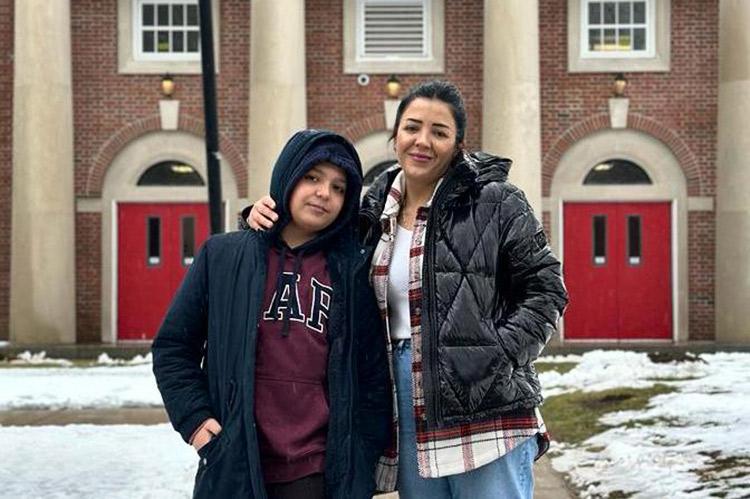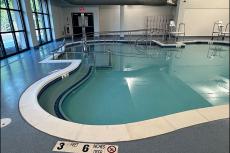Sultan Kilic was sleeping in her sixth-floor apartment in Adana, Turkey, with her 10-year-old son, Cagan, at 4:30 a.m. on Feb. 6, when the earth began to speak, and their building began to shake.
“The noise is a deep low voice that doesn’t come from one source. It’s like a voice coming from everywhere. Everything vibrates with it,” said Ms. Kilic’s friend Zeynep Gunduz, a Sag Harbor architect who moved here from Turkey in 2018.
Ms. Gunduz translated for Ms. Kilic as she told her story of survival to The Star from the safety of the John Jermain Memorial library.
As her building swayed, Ms. Kilic ran into her son’s room and looked into his eyes. The fear she saw is imprinted on her memory. He was confused, and Ms. Kilic had to convince him he was awake. For the next minute and a half, the two would live through a nightmare that is difficult for New Yorkers to comprehend.
“We formed a ‘life triangle’ and waited to die. In that minute and a half, I lost 15 years of life. I told him to remember his drills from school and told him we would be fine. He said, ‘Mom, let’s go out of the apartment, I don’t want to die,’ ” said Ms. Kilic.
“I held him close, because I was sure the building was going to collapse, and I wanted to die hugging him. Through God’s mercy we survived. We waited for the shaking to stop and then we left the apartment.”
Adana is a city of three million about 134 miles away from the epicenter, in
Gaziantep, of the 7.7-magnitude quake. In our terms, it’s a drive to Newark Airport. So, to get a feel for the range of destruction, imagine an earthquake in New Jersey leveling a house on the South Fork.
The Gaziantep earthquake was Turkey’s most deadly in 80 years. Since Feb. 6 there have been 7,500 aftershocks, some quite strong. On Monday, a 5.2-magnitude quake hit Kahramanmaras, only 20 miles from Gaziantep. Over a million people have been left homeless.
“We thought Adana was the center because it was very intense,” said Ms. Kilic. “I can’t even imagine what it must have been like at the center.”
Outside their building in the dark before sunrise, it was raining, and the ground was muddy. Adana is a southern city, and the climate is similar to that of Virginia, but they were cold. People were screaming and panicking. Groups formed to begin to help people escape from nearby buildings that had collapsed.
In the immediate aftermath, they could feel aftershocks every five or 10 minutes. She went to her sister’s apartment because she lived on the ground floor and they felt safer there.
They were in her apartment later that afternoon when the second earthquake hit.
“We escaped barefoot. We looked back at her building, and it was still moving. Many buildings that were disturbed in the first quake collapsed in the second,” she said.
Ms. Kilic’s eyes watered as she used a tissue box to demonstrate the swaying buildings.
One building completely collapsed. Next to it, another half of a building collapsed. “Rescue teams tried to check the building, but no one could do anything. They wouldn’t move a stone because the risk was too great the other half would collapse. Eighty-eight people were left to die there. No one came out alive,” she said.
For the next two weeks, Ms. Kilic and Cagan lived outside, wearing the same clothes they wore the day the earthquake struck. Many cities still do not have tents. Some people are living in their cars. After a third strong aftershock, she made her way to a nearby airport and flew to New York, via Istanbul.
Twenty years ago, a similar earthquake hit close to Adana, and they lost buildings, though not as many. Ms. Kilic was perplexed and angry that brand-new buildings constructed since that earthquake had collapsed, and believed building inspectors were bribed.
“The earthquake didn’t kill people,” she said. “Greed kills people. The greed of the people in the building departments who give permission for builders to construct buildings that are inappropriate in an earthquake zone.”
In an email, Ms. Gunduz said that after the 1999 earthquake in Duzce, the Turkish government began to collect an “earthquake tax” to “create a fund to be used in preventative actions like reinforcing the buildings, urban transformation, and after-shock organizations like mobile hospitals and kitchens, tents, and container houses. But that money is long gone, and they cannot explain what it was used for.”
As an architect, she believes “concrete is too rigid and too heavy” for earthquake zones and that building codes are “not enforced properly.”
Both women say the government is untrustworthy and donations should be directed to nongovernmental organizations only.
Ms. Kilic will stay in Sag Harbor with Ms. Gunduz until her visa expires. Cagan started at Sag Harbor Elementary on Tuesday. She says she will never feel safe in Turkey again. “I have no hope it will ever get better there.”
She recalled watching an old lady, rescued from rubble, blinking in the sudden daylight. The woman thought the world had ended. She refused to believe people had survived and were continuing to live.
Indeed, Ms. Kilic is alive and well, but she feels guilty for leaving. “My mind is still in Turkey. I’m happy for my son, but I’m ashamed because I got away from all that pain.”
Bay Street Theater is holding a benefit concert for Syria and Turkey at 7 p.m. next Thursday hosted by Jay Schneiderman, the Southampton Town supervisor, with money raised going to Oxfam International. Tickets are only $20.
“What happened in Turkey is a terrible tragedy and we should do whatever we can to help,” said Mr. Schneiderman, who offered a moment of silence at the start of the Feb. 14 Southampton Town Board meeting. “It’s important that the Hamptons steps up and responds to international tragedies like this in some way. Where there is great wealth, there is great responsibility.”




